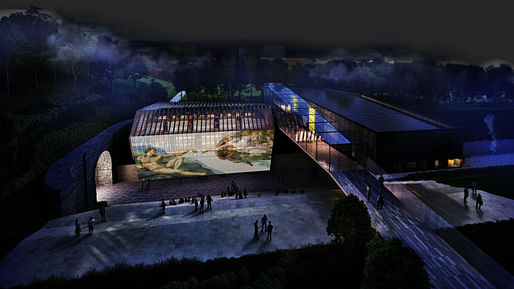
An imposing new cultural project will transform what was once a railway link in the Welsh countryside into what London-based studio Scott Browrigg says will be the world’s longest digital art space once it is completed in a few years.
By remaking the last vestiges of a 130-year-old abandoned rail tunnel formerly pegged to become a walking path and bike trail, the new arts-centered scheme will deliver an in-demand tourist destination that connects the two communities of Blaencwm and Blaengwynfi located at either end.
One might say this is a real windfall for the critically-important (especially in terms of an exhibition settings) area of wayfinding. The design made the cut for the recently-announced 2022 WAF shortlist in the Future Project: Culture category and will strive for a BREEAM Excellent rating, according to the firm.
To the east, the tunnel’s entrance will be defined by either a land art referencing hotel, while in its west, on the Blaengwynfi side, a new visitors center will be erected to welcome completed with performance spaces, a digital theater, and elevated exhibition galleries clad in timber and shaped in the form of coal in a nod to the site’s original historic usage. This is added to by another double-height exhibition space and outdoor amphitheater located beside the opening of the tunnel, the passage through being cleared of any obstacles that might interfere with what a press announcement called the “natural passive surveillance.”
Per the architects: “Following structural repair and restoration, the almost two mile long tunnel will open to the public as a pedestrian and cycle route, digital art gallery and performance space. Elevated for safety, the pedestrian route provides a different perspective of both the tunnel and digital art installations. Working alongside digital art consultancy Lumen Art Projects, ideas were explored for installations that would spark the imagination and tell tales of the tunnels past.”

“Existing light wells and ventilation shafts lined with metal create an immersive experience as they capture sounds of the valley, or broadcast music performances to communities above ground. The largest light well is turned into a means of escape and evolves into a viewing tower above – a brass with perforated steel exterior references the brass bands of the mining valley. Visitors can also learn about the history and construction of the tunnel at the visitor centre.”


“A materials palette of timber, glass and greening reflects the rural setting and supports the sustainable agenda. Rainwater and run-off is collected within a rain garden, and used to reduce fresh water demand and consumption.”
No construction dates were made available at press time. Stay tuned to Archinect for more updates on this and other WAF shortlisted projects.
No Comments
Block this user
Are you sure you want to block this user and hide all related comments throughout the site?
Archinect
This is your first comment on Archinect. Your comment will be visible once approved.